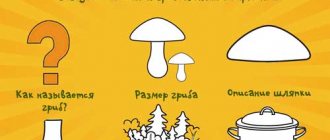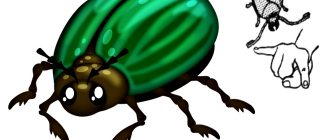Lesson summary for 1st grade students of the 8th grade correctional school on the topic “Utensils”
Lesson for students of 1st and 2nd grades of the 8th type correctional school.
Topic “Utensils” Description of the material: I offer a summary of a correctional and developmental lesson with children for students in grades 1 and 2 of a correctional school of type 8. In this lesson, children are offered various tasks and exercises to develop the cognitive sphere (attention, memory, mental operations), as well as the emotional-volitional sphere. This material will be of interest to teachers - psychologists, speech pathologists, primary school teachers, educators. Goal: correction and development of students’ cognitive processes with the help of specially selected games and exercises. Objectives: • consolidate children's knowledge about dishes; • develop auditory and visual attention, short-term and visual memory, general and fine motor skills. • develop cooperation skills and a positive attitude towards participation in the lesson. Equipment: ball, pictures of dishes, task cards, pens, pencils.
Course of the lesson
Introductory part. Organizing time. Greetings. Psychologist: Hello, guys! I'm very glad to see you! I suggest we greet each other as follows. “Let's say hello” Children, at the psychologist's signal, begin to move chaotically around the room and say hello to everyone who meets on their way. 1 clap – shake hands 2 clap – shake elbows 3 clap – shake backs Main part Exercise “Broken dishes” Instructions:
collect pictures.
Psychologist: guys, we collected pictures. How can we describe in one word what we did? ( dishes
).
That's right, the topic of our lesson is “Dishes (there is a poster with a picture of dishes on the board). Exercise “Divide into 3 groups” Instructions:
paint the dishes blue, the toys red, the clothes green.
Exercise “Confusion” Instructions:
circle all the objects in the picture with different colors, give a name to all these objects.
Physical education lesson about dishes Here is a large glass teapot, (“puff up” your stomach, one hand on your belt)
Very important, like a boss.
(the other hand is curved like a nose)
Here are the porcelain cups,
(squat)
Very fragile, poor things.
(hands on the belt)
Here are the porcelain saucers,
(spinning around)
Just knock and they will break.
(drawing a circle with his hands)
Here are silver spoons,
(stretch, clasp your hands above your head)
Here is a plastic tray - He brought the dishes to us.
(make a big circle) Exercise “Place in place.” Instructions:
use the arrows to place the tea utensils on the table, the dining utensils in the closet, and the kitchen utensils on the stove.
Ball game “Call it affectionately” Saucepan – saucepan
Plate –
plate
Knife –
knife
Fork –
fork
Spoon –
spoon
Frying pan –
frying pan
Saucer –
saucer
Cup –
cup
Glass –
cup Exercise “Find the shadow” Instructions:
recognize the utensils by their silhouettes. Connect the pictures that match each other with arrows.
Reflection. Summarizing . Children pass the ball and say what they remember and what they liked. Psychologist: thank you all, well done!!!! Goodbye.
We recommend watching:
Correctional and developmental lesson for grades 1-2. Lesson summary for children with disabilities for grades 1-2. Body parts. Emotions Technological map of a correctional lesson for the protection of residual vision and the development of the visual in Notes of the educational hour for the preparatory class
Similar articles:
Summary of correctional lesson in 1st grade
Preparing for the drawing lesson “Dishes”
Drawing dishes is carried out simultaneously with the study of this topic in cognitive and speech classes. Children convey the characteristic features of everyday objects in drawings:
- shape (bowl, plate - round, cutlery - oblong),
- size (saucer smaller than plate, for example),
- color and pattern,
- purpose (glass - for compote, bowl - for vegetables).
Children can draw and paint dishes
Paints and base for painting
- Gouache is the paint of choice for painting with 5 year olds. Lines and strokes are clearly laid out, the color is rich. You can use watercolors (after all, these paints are cheaper than gouache).
- Brushes: thick and thin made of natural bristles.
- Colored pencils (not wax).
- Landscape sheet or half: white,
- tinted with watercolor paint (by the teacher).
Advice. Save markers for drawing details in the older group, and leave wax crayons for unconventional techniques with watercolors. The purpose of classes in the middle group is to teach object drawing with pencils and paints.
Gouache works best for children 4–5 years old to color.
Drawing technique
- Practice drawing shapes: with a finger/dry brush in the air or on a desk.
- Drawing an outline on paper (brush or pencil).
- Coloring: pencil shading,
- strokes of paint.
- border,
Painting utensils may include coloring and decorating
Video: drawing lesson for children “Cup and teapot”
The drawing lesson is intended by the author for children from three years old. In fact, primary and secondary preschoolers will be able to reproduce only part of what is shown in the video: the shape of a cup (semicircle) and a teapot (circle), painted over and completed with pens, a simple pattern.
Decorating a drawing or paper blank on the topic “Dishes” can be done using an unconventional technique:
- fingers,
- cotton swabs,
- stamps,
- imprinting dry leaves, cut fruits.
Photo gallery: drawings of dishes using non-traditional techniques
It’s fun to draw with a cotton swab; you get even peas
Children use their fingers to draw in the style of dot painting.
Leaf prints on the plate form a beautiful pattern
You can make stamps for decorating plates yourself: cut them out on pieces of vegetables
How to decorate a drawing
Aesthetic education of children is carried out in the interrelation of play, productive creativity, and the influence of the developing environment. Fine arts classes have one of the main objectives - to instill a sense of beauty in the younger generation. Stimulate and encourage the child’s desire to further decorate the drawing with various materials:
- plasticine circles (mosaic) or strokes (plasticineography),
- pieces of fabric, colored or wrapping paper (applique),
- glitter.
Plasticine elements can be used to mark the contours of dishes and make a three-dimensional pattern.
Individual tasks
An individual-personal approach to the work of a teacher is to adapt the conditions for each child in such a way that the tasks are feasible and at the same time develop. There are children in the group whose skills are still less developed than those of their peers - for them it is worth simplifying the task. But gifted children will quickly cope with the general task and get bored - they need more complicated tasks.
An example of multi-level tasks in the “Cup for Grandma” lesson:
- simplified - trace the stencil of the cup, outline the outline with gouache, paint over it, decorate with pieces of plasticine;
- general - draw a cup, color it, add a polka dot pattern;
- with a complication - draw a cup, decorate it in the style of folk crafts (Gzhel, Khokhloma).
In addition, you can individualize the task for everyone: through the choice of a tinted base, blank, stencil or paints. Children love being trusted to figure out some of the work themselves.
The ability to independently choose a subject to draw motivates children
Place of classes in the card index for visual activities
The topic “Utensils” is general and significant for different classes in the middle group. Children will learn what types of utensils exist and what materials they are made from. The culture of behavior at the table and eating food is covered in role-playing games.
During art classes, children depict familiar types of dishes. Individual works can be compiled into a collective composition. The theme of dishes and utensils is interpreted in drawing classes in a variety of formulations:
- “Cup for mommy”, “Tea pair” / “Cup and saucer for beloved grandmother” (for a gift on March 8),
- “Bowls of Three Bears” (individual composition to maintain proportions),
- “Treat for friends”, “Plate with vegetables/fruits” (drawing a base for plasticine fruits),
- “Gzhel patterns” (decorative drawing),
- “Dishes for Fedora” (collective composition based on the poem, the teacher draws Fedora based on it),
- “Tea service” (collective composition).
The drawings of all pupils can be arranged, for example, into the composition “Tea Party”







